Although I have only seen a short excerpt of their work, my first encounter with Maria Kong – the new Israeli contemporary dance company whose first work “fling” will be performed September 8 – 10th at the Nachmani Theatre – left me with a desire to see and hear more. In an interview with the dancer/choreographers – Anderson Brass, Talia Landau, Leo Lerus and Yaara Moses, I found them to be articulate, self-aware, scientific and soulful, friendly and enigmatic. Talia was the main spokesperson, yet made it clear that she is “the voice of the dialogue putting together the sentences of everybody that makes a clear voice.”
What is dance for you?
Talia: In Maria Kong when we treat dance we don’t take it as an obvious form of movement. We research options together with reasoning. If someone wants to get to some point in space there should be a very good reason for him to get there. That is the base of reason and movement but at the same time there is an individual way of moving, an individual way of interpreting and we try to use that in a very large range. Both the character as a physical form and the physical dancer. We try to cover a lot of that person, that unit’s options to move. It’s not only about the dancer’s experience or about the visual. We are formatting a whole format that we work with, that we research by doing it over and over and trying different angles of it.
Yaara: I think as well that we treat dance not only in the physical but also we treat the space, the atmosphere, the relationship and how we react to each other and this all together creates its not only like form or…
Leo: Once we started this project of Maria Kong …because we are very passionate to the dance art I think what has happened is that we realize that dance is very much a live art form. It’s what happens at the moment. What happens with the moment can be mesmerizing because of the honesty that it has, the right vibrations that it has, you know. I think we work a lot on finding the right reasoning for what we do and I think we work a lot as well on the timing. We work so much on an instinctive reaction. It’s like we’re reacting to one another. We’re not taking movements from each other so there’s…
Talia: I’ll give you an example. I can physically show you. We both (Talia demonstrates with Leo, who is sitting next to her on the couch) need to do with the arm like that (swirling wave in the air, circling near head) and cut it. So it won’t be I tell him “ok Leo when she’s exactly there you cut it.” Because then [by relying on one dancers response to the other, rather than to a count or predetermined cue] we get a format that constantly needs to go back and forth. We believe that in the format of chance, of sensitivity, of timing – there’s more magic. So if he does that and I cut and we continue then we can continue riding together. This is very hard to explain, you’re asking a deep question, so it’s hard to explain.
In “fling” all four participated as choreographers of different sections, and as dancers. I asked them to describe that process.
Talia: There are endless options. One is you use an extended version of how that dancer interprets what you want. You show him a movement and his interpretation of it and then you fine tune it. And then another dancer – the same. And now they have two different languages. When they use their dancing together they also feel the right timing and the magic starts. When we like something we don’t try to force and say ok let’s do it again, we try and find why it worked.
Yaara: There is a lot of listening.
The four dancers met in the Batsheva Dance Company, which formed the greater part of both Yaara and Talia’s dance career. I asked if they had concerns about the “anxiety of influence.”
Talia: I’ll tell you something. I had the greatest pleasure. I did Gvanim Bemahol (Shades of Dance – a dance festival at Suzanne Dellal for young choreographers) when I was 19, with Naomi Perlov, and Ohad invited me to start training with the junior company. I had the greatest privilege to not only train for the nine, ten years I was there but to constantly create and to research creatively. I had the most amazing studios, the most amazing opportunities, the most phenomenal dancers.
Yaara: You were encouraged.
Talia: I was encouraged constantly by Ohad and by Naomi and by everyone in Batsheva on developing as a dancer and as a creator. You get there so much of the guidance of how to be strong and believe in what you do that it’s very natural that you will have seeds that start to develop there and they’ll just want to keep on growing.
Leo and Anderson had danced in very different companies before joining Batsheva in 2005. I asked both to comment on some of their past experiences:
Anderson: I’ve had classical training since I was 13. I was doing classical ballet but I was doing just for warming up. Since the age of 16 I was doing already modern and contemporary. And changing companies all the time and working with different choreographers. Batsheva was a totally different language that I really wanted to learn. Whatever I did in Brazil was a very different way of dancing. It was pretty much outside – in. I would feel things of course but it will be me, Anderson, bringing it. When I got here it was the opposite. They were bringing me asking and moving me inside to be able to dance and it was a very special language which is Ohad and Batsheva. A very beautiful tool for a dancer.
Leo: My process has been very different to you [referring to Talia, who danced longest in Batsheva]. I think what I had to face was the fact of having danced for so many different choreographers. I’ve been working for so many years for so many different styles that for me, I almost felt that I am entering the studio for once facing myself and I had to figure that out.
As a former dancer in the Random Dance Company, do you feel that Wayne McGregor was an influence?
Leo: I think Wayne McGregor has been quite inspiring for me to see how his approach to his piece is very, very vast. He’s working into the media of dance but in terms of the process that we always did in these pieces he’s very vast in terms of how much he works with the composer of the music, how much he’s putting movies or animation into it, how we work with scientists as well. He kind of opened up my mind in terms of how vast the creation can be if you are a choreographer or a dancer. It’s not just about learning the steps.
The four dancer/choreographers share a wonderful intimacy that has its foundations in their shared experience in Batsheva:
Talia: What’s amazing about this team is that we all grew there [Batsheva] and we grew mostly to appreciate each other as hard workers, as people that love to work, love to dance and love to give themselves totally to what’s done. That gives us a base of dialogue and of creativity and of dancing. You know, its like the sky’s the limit when you have a team like that, that’s how I feel.
Yet the Maria Kong team extends beyond this group of four, to include visual artist Ori Ben Shabbat and costume designer Miki Avni. How does the intimacy and depth of their relationship work with bringing other people into the process?
Talia: They start with us from the beginning. There’s no gluing, we don’t glue artists to our art. There’s a combining, everybody puts the art at the center and we look at it. We all work for a goal: for this art to become what it wants to become. We want to help it become what it wants to be. We talk about Maria Kong – she makes us do what she wants us to do. She has a kind of spirit, the same thing with the art. There’s a kind of feeling like a magnetic force that pushes the art to become and you kind of just want to say – wait wait and before you close I want to add here…and you kind of try and help it not close before it’s ready.
How do you know it’s ready?
Talia: That’s why there’s a lot of brainstorming done in this group – like intense brainstorming. I would say its almost 24 hours brainstorming cause even if we’re not in the studio doing it, we’re on the phones doing it, in the street doing it, in the coffee shop doing it…
Yaara: SMS
Talia: Its not an easy challenge, I would say it’s a huge challenge to do that [artistic collaboration]. Sometimes you have to put yourself and what you think on the side and to try to look in the most objective glasses you can and with open heart. Leaving your heart open is a very big challenge just as much as leaving your mind open.
Yaara: I think we all found out that when we had issues or problems, actually in perspective just brought us to better solutions and opened new ways of the art to get to what it wanted to be.
Leo: I think it’s essential when you feel that you are responsible for what happens in Maria Kong to be the best it can be. When you have that kind of responsibility then you very easily, it’s not always easy, but you get to this place of having to serve this virtual entity more than yourself. I think its how we position ourselves. We are passionate people, hungry, that want to learn from creation. I think it’s very nice to feel that you are part of something that is bigger than you. In terms of Maria Kong or the art that we hope to achieve, it’s bigger than ourselves so therefore it’s true that the ego part is not necessary when you have a process like that.
When the interview ended, we found we still had a lot to talk about (as you may recall, I found the four to be very friendly). Talia discussed the inspirations for their work; and my notebook came out again.
Talia: Our inspirations can be anything from a play, to a painting, to a video game.
It’s not so much about trying to imitate something we like, but trying to understand why does that work? What is it about the video game that the visual and timing of the sound what is it about it that works? Timing as Leo said before is a very big deal in all these arts. It can be the timing of putting the right sentence in a book; it can be the right timing, the right lighting, the timing between elements. I find it fascinating and it can be done in so many different ways. When you look as a movie as a form, you can look at it as a movie but you can look at it as an architecture. You can look at a video game as a structure and if you get your mind blown by the structure you feel someone just made a difference in you.
We come a lot with information from books we all read and think about information and then we talk about how it can be translated physically. [for example] Sartre’s play, No Exit – format of three and the constant transfer between them, the constant ping-ponging between characters keeps everything alive when actually captured in a closed space. Lets say Federico comes in a day when Anderson is a bit heavy or a bit down or up or any kind of …and Gomiez has to react to that he cannot ignore the state of mind so we research that a lot. The timing –Leo mentioned that earlier— it’s a live show, if he doesn’t react on real, there’s something not happening.
Yaara: As well in the process, we’re constantly nurturing “it” from many, many sources. As individuals we go out, we see stuff we read books, we see plays, and we bring this impact so we’re constantly changing and growing to what we are today every day.
Image credit: Gadi Dagon
Performances:
September 8 – 10
Nahmani Theatre
4 Nahmani Street, Tel Aviv
Tickets: 03-5624091
info@mariakong.com

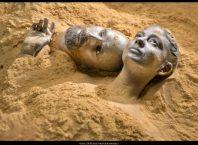
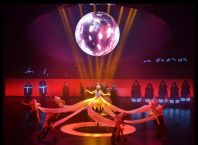
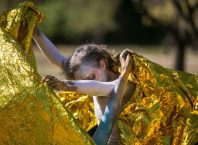
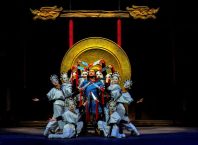
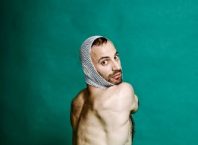
it’s a birth : it’s fresh , organic, and liiive
I wanna see that “fling” again and again
enjoy Silo
Comments are closed.